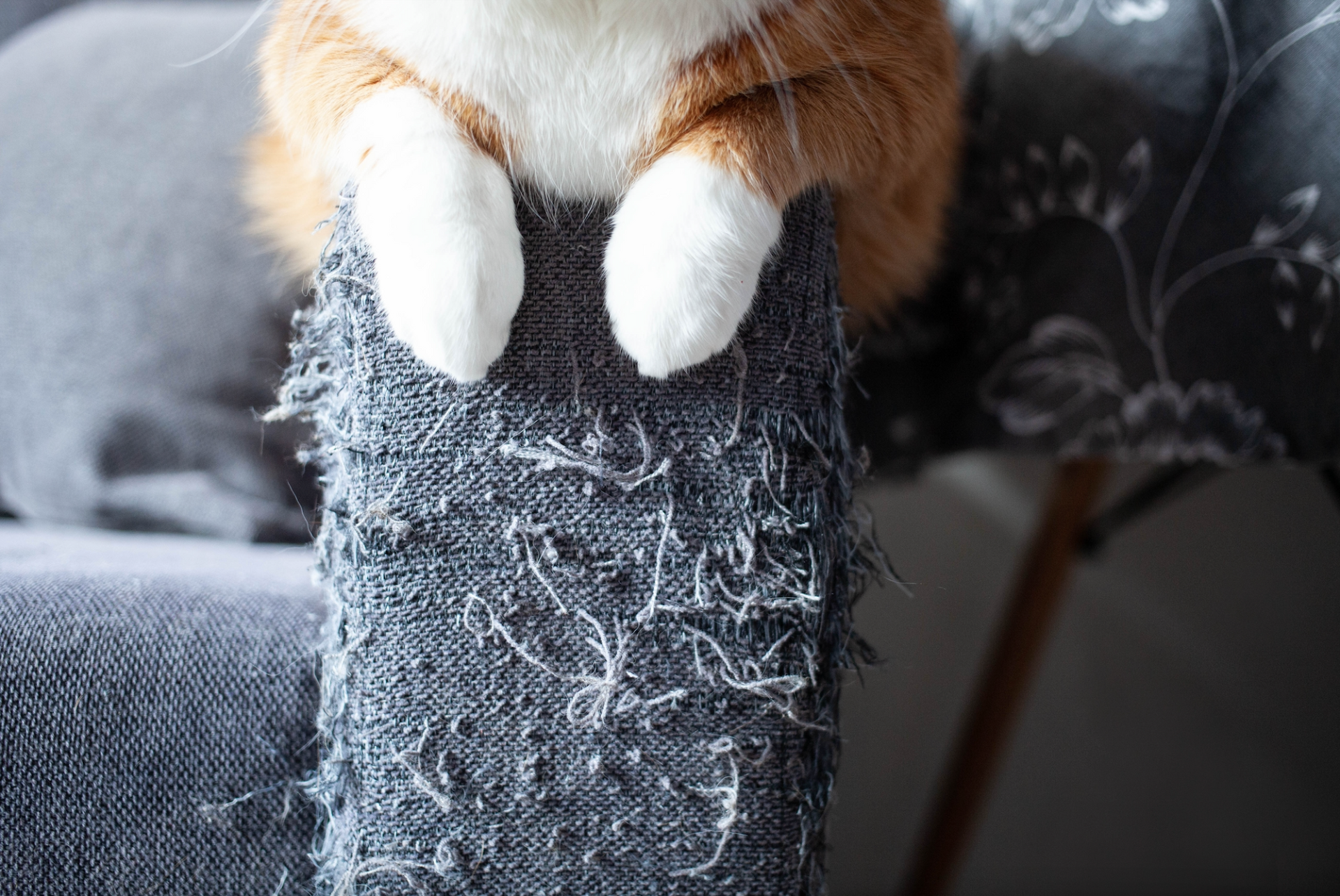Do you know the horror of seeing your cat turn the arms of your favorite comfy chair into ribbons? We feel your pain. We also know why cats scratch—and how to redirect their behavior to good places.
Why Do Cats Scratch?
Why do cats scratch furniture and carpets? Worse yet, why do cats scratch the walls at night? We used to find ourselves muttering these questions under our breath constantly, and if you’re reading this…you probably get it.
The good news is that there are logical reasons why cats dig their claws into your home’s soft surfaces. Once you understand them, you can find ways to make those classic cat behaviors less painful for your furniture.
Cats love to mark their territory, and that’s exactly what your home is for them. Every swipe of your cat’s nails leaves behind scratch marks and pheromones from the scent glands in their paws that will let any feline visitors know exactly whose turf this is—you know, just in case you start letting neighborhood cats tour your living room. Even if it doesn’t make a lot of sense for indoor cats, this is a natural behavior that keeps them enriched and happy.
Scratching is also good for cats’ physical health! Cat’s claws shed their outer layers as they grow, and scratching helps to pull off the old layers and leave the claws underneath sharp and ready for action. We also all know that cats love a good stretch, and reaching alllllll the way to the top of the scratching post gives them just that. A good stretch-n-scratch can even be a way to show their contentment—which might be why your cat scratches when you pet them.
The point is, scratching is good. The goal isn’t to stop them from scratching entirely (and definitely not to declaw them, which is painful, unnecessarily dangerous, and incredibly distressing for a cat). Instead, we’re going to show you how to stop cats from scratching furniture by working with their natural instincts.
How to Manage Cats’ Scratching
Redirect to Approved Scratching Spots
The truth is, you’ll never stop a cat from scratching—you can’t fight instinct! Instead, the key is to encourage your cat to scratch on scratching posts and other human-approved locations (i.e. not your couch).
- Get them a variety of scratching posts and cat trees—try upright and flat posts and an assortment of materials including rope, cardboard, and wood. (Consider skipping carpeted posts because it might be confusing if your cat can scratch carpet there but not in the rest of the house.)
- Place posts near (or even blocking) their current favorite scratching spots.
- Place other posts by their favorite spots to hang out—by the litter box, next to your usual spot on the couch, or by their go-to nap spot for a good stretch when they wake up.
- Make the posts tempting by rubbing them with catnip and decking them out with your cat’s favorite toys.
Discourage Scratching Bad Spots
Once you’ve offered better places to scratch, the next step is to make their old targets less appealing. Some cats might easily transition over to their scratching posts, but these tips will be essential for the cats who scratch everything but the post.
It’s important to note that we DON’T recommend yelling at, scaring, or spraying your cat when they scratch. You can move them away from the spot when necessary, but if you’re the one scolding them, they might associate the scary stuff with you instead of the scratching. You can stop Googling homemade sprays to stop cats from scratching furniture and take a much less invasive approach!
- Remove or block their usual scratching surfaces wherever possible. For instance, if they scratch your speakers, turn them to the wall temporarily.
- Cover the scratched areas in an unpleasant texture like double-sided sticky tape or tin foil. If it doesn’t feel good to scratch, they won’t scratch it.
- Use bumpy carpet runners or crinkly tin foil to make the spots they would usually plant their feet to get their scratch on less comfy.
Don’t worry—you won’t have a tin foil-covered couch forever. These changes are all temporary and you can wean your cat off of them as they break their old habits and start scratching in better locations.
Take Care of Those Claws
It’s a good idea to reduce scratching damage by keeping your cat’s nails short and smooth. You can use nail clippers made for cats or a nail grinder to keep their nails trimmed. Read our full guide on how to trim your cat’s nails here.
You can also try applying cat nail caps after your nail clipping session. These soft plastic covers are glued over each claw and will naturally fall off when the top layer of the nail sheds. They’re pain-free and prevent most scratching damage, but some cats dislike having their claws covered and will do their level best to yank that kitty manicure right off. You’ll have to test your cat’s tolerance and respect their boundaries if they keep up their protests after a couple of tries with the nail caps.
,

